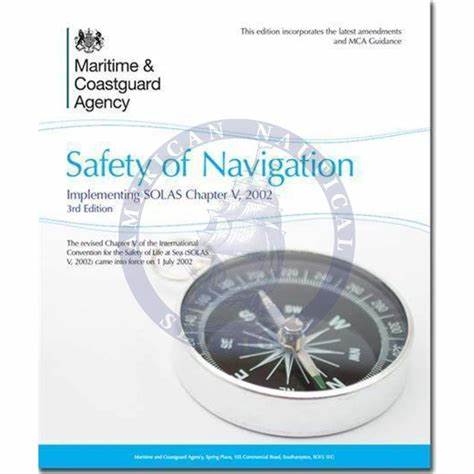Explore SOLAS Chapter V’s role in maritime navigation safety, its key regulations, practical applications, and future developments.
Navigating the Seas Safely
Maritime navigation has always been fraught with challenges—from unpredictable weather to human error. To mitigate these risks and ensure the safety of life at sea, the International Maritime Organization (IMO) established the International Convention for the Safety of Life at Sea (SOLAS). Among its various chapters, Chapter V stands out as it addresses the safety of navigation, applying to all ships on all voyages.
This article delves into SOLAS Chapter V, providing insights for beginners, students, professionals, and general readers. We’ll explore its historical context, core principles, practical applications, challenges, and future trends, offering a comprehensive understanding of its impact on global maritime practices.
Background & Historical Context
The SOLAS Convention was first adopted in 1914 in response to the Titanic disaster. Over the years, it has undergone several revisions to address emerging maritime safety concerns. The current version, SOLAS 1974, has been amended multiple times, with Chapter V focusing on the safety of navigation.
Chapter V is unique as it applies to all ships on all voyages, regardless of size or type, emphasizing the universal importance of navigational safety. It encompasses a range of regulations designed to enhance the safety and efficiency of maritime navigation.
Key Concepts, Definitions, and Framework
SOLAS Chapter V comprises various regulations that collectively aim to ensure safe navigation. Key areas include:
Navigational Equipment Requirements
Ships are required to be equipped with specific navigational tools, such as:
-
Magnetic and gyro compasses
-
Radar systems
-
Automatic Identification Systems (AIS)
-
Electronic Chart Display and Information Systems (ECDIS)
-
Speed and distance measuring devices
These tools aid in accurate navigation, collision avoidance, and situational awareness.
Voyage Planning
Masters are mandated to plan voyages considering factors like:
-
Weather conditions
-
Tidal information
-
Navigational hazards
-
Availability of navigational aids
Comprehensive voyage planning ensures preparedness and reduces risks during transit.
Ship Reporting Systems
Certain areas require ships to report their positions and other relevant information to shore-based authorities. These systems enhance maritime traffic monitoring and facilitate timely assistance during emergencies.
Vessel Traffic Services (VTS)
VTS are shore-based systems that monitor and manage ship movements within specific areas, particularly congested or sensitive regions. They provide navigational advice and information to vessels, promoting safe and efficient traffic flow.
Navigational Warnings
Timely dissemination of navigational warnings, such as Notices to Mariners, ensures that ships are aware of potential hazards like:
-
Obstructions
-
Adverse weather conditions
-
Changes in navigational aids
These warnings are crucial for real-time decision-making during voyages.
Practical Applications & Case Studies
The implementation of SOLAS Chapter V has led to significant improvements in maritime navigation safety.
Enhanced Navigational Practices
Mandatory voyage planning and the use of advanced navigational equipment have reduced incidents of groundings and collisions. For instance, the integration of ECDIS allows for real-time route monitoring and hazard detection.
Improved Emergency Response
Ship reporting systems and VTS have facilitated quicker response times during emergencies. In areas like the English Channel, VTS centers coordinate closely with vessels to manage traffic and respond to incidents efficiently.
Environmental Protection
By promoting safe navigation, SOLAS Chapter V indirectly contributes to environmental protection by reducing the likelihood of accidents that could lead to oil spills or other hazardous material releases.
Challenges & Criticisms
Despite its benefits, SOLAS Chapter V faces several challenges:
Technological Disparities
Not all ships, especially older or smaller ones, are equipped with the latest navigational technologies, leading to inconsistencies in compliance and safety standards.
Human Error
While technology aids navigation, human error remains a significant factor in maritime incidents. Ensuring proper training and adherence to procedures is essential.
Implementation Variability
Differences in national regulations and enforcement can lead to uneven implementation of SOLAS Chapter V provisions, affecting overall effectiveness.
Future Trends & Developments
The maritime industry continues to evolve, and SOLAS Chapter V is expected to adapt accordingly.
E-Navigation
The IMO’s e-navigation initiative aims to integrate existing and new navigational tools to enhance safety and efficiency. This includes the development of standardized digital services and improved data exchange mechanisms.
Autonomous Vessels
As autonomous ships become more prevalent, SOLAS Chapter V may require updates to address new navigational challenges and ensure safety standards are maintained.
Cybersecurity
With increased reliance on digital systems, protecting navigational equipment from cyber threats is paramount. Future regulations may incorporate cybersecurity measures to safeguard maritime operations.
Conclusion: Steering Towards Safer Seas
SOLAS Chapter V plays a pivotal role in ensuring the safety of navigation across the globe. By mandating essential navigational equipment, voyage planning, and reporting systems, it enhances maritime safety for all vessels. Continuous adaptation to technological advancements and emerging challenges will ensure that SOLAS Chapter V remains effective in safeguarding lives and the marine environment.
Frequently Asked Questions (FAQs)
Q1: What is SOLAS Chapter V?
A1: SOLAS Chapter V is a section of the International Convention for the Safety of Life at Sea that focuses on the safety of navigation, applying to all ships on all voyages
Q2: What equipment is required under SOLAS Chapter V?
A2: Ships must be equipped with navigational tools such as compasses, radar, AIS, ECDIS, and speed measuring devices to ensure safe navigation.
Q3: How does SOLAS Chapter V enhance maritime safety?
A3: By mandating voyage planning, navigational equipment, reporting systems, and VTS, it reduces the risk of maritime accidents and improves emergency response.
Q4: Are there challenges in implementing SOLAS Chapter V?
A4: Yes, challenges include technological disparities among ships, human error, and variability in national enforcement of regulations.
Q5: What future developments are expected in SOLAS Chapter V?
A5: Anticipated developments include integration of e-navigation systems, regulations for autonomous vessels, and enhanced cybersecurity measures.
Further Reading
Note: This article is intended for informational purposes and does not constitute legal advice.

